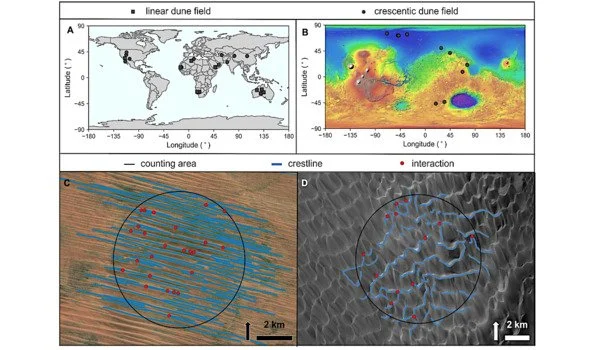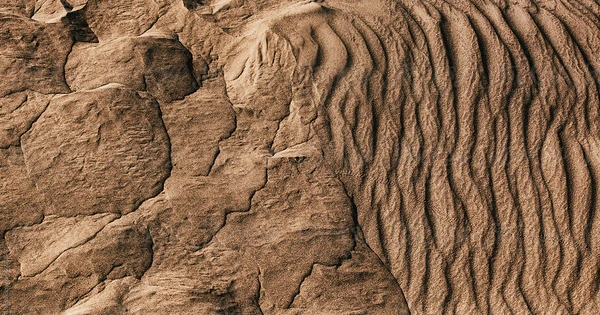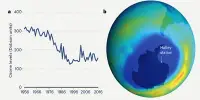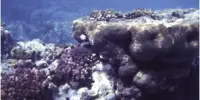Dune patterns can definitely disclose crucial information about Earth’s and other planets’ environmental changes. Dunes are generated by the flow of sediment-carrying wind or water, and their properties are controlled by a variety of environmental conditions.
Researchers examined the altering patterns of entire dune fields on Earth and Mars as seen from space and discovered that they are a direct result of recent environmental change. This new technique can be used on any planet with dunes, including Mars, Titan, and Venus.
Dunes, which range from ripples on the shore to towering behemoths in the desert, are manifestations of surface processes, climate change, and the surrounding atmosphere. Scientists have been baffled for decades as to why they produce diverse patterns.
Now, Stanford researchers have found a way to interpret the meaning of these patterns. Their results, published in Geology, can be used as a new tool for understanding environmental changes on any planetary body that harbors dunes, including Venus, Earth, Mars, Titan, Io, and Pluto.
When you look at other planets, all you have is pictures taken from hundreds to thousands of kilometers away from the surface. You can see dunes – but that’s it. You don’t have access to the surface. Our findings offer a really exciting new tool to decipher the environmental history of these other planets where we have no data.
Mathieu Lapôtre
“When you look at other planets, all you have is pictures taken from hundreds to thousands of kilometers away from the surface. You can see dunes – but that’s it. You don’t have access to the surface,” said senior study author Mathieu Lapôtre, an assistant professor of Earth and planetary sciences in the Stanford Doerr School of Sustainability. “These findings offer a really exciting new tool to decipher the environmental history of these other planets where we have no data.”
The scientists researched how 46 dune regions on Earth and Mars interact, or trade sand, by analyzing satellite photographs of the dunes. Physically, dune interactions appear as areas where the crestlines of two dunes are relatively near to one other. Dunes evolve toward a defect-free pattern as a result of such interactions, representing a state of equilibrium with local conditions. As a result, the researchers argued that a large number of contacts must indicate recent or local changes in those border circumstances. To put their concept to the test, they analyzed data from Earth and Mars to see how known changes in environmental factors, such as wind direction or sand availability, affected dune interactions in dune fields.

Finding a pattern
In a part of China’s Tengger Desert, researchers once flattened a dune field to have a baseline for understanding its subsequent reformation. The study authors analyzed satellite images of the dune field from 2016 to 2022 to see how it grew from a flatbed to large dunes in equilibrium with their environment.
“When the dunes and their patterns were not in equilibrium with their current conditions, the interaction density was high, and through time we could see it decreased consistently, as is expected from our hypothesis,” Lapôtre said.
Next, they investigated dunes migrating through a valley in the Namib Desert to see how changes in the wind conditions, triggered by topography, impacted dune patterns. They found that dunes outside the valley displayed few defects in their patterns, but as they migrated through the valley — which starts very wide, then narrows, then becomes wide again — dunes interacted more with each other.
“As both sand and winds get funneled into the valley, the dunes feel a change in their boundary conditions, and their pattern needs to adjust,” said lead study author Colin Marvin, a PhD student in Earth and planetary sciences. “They move into the portion outside the valley and they again readjust to their unconfined conditions, and we see a drop in the number of interactions. This trend is exactly what we expected to see.”
They discovered the same pattern on Mars, where a large dune field appears around the north pole. There, the moving dunes have settled into their current circumstances — they’re well spaced, look the same, and are the same size — and as a result, they interact with one another relatively little. However, as one moves downwind, the winds become more unpredictable, and frost makes it difficult for grains to be blown away. The dunes react to the change until they have migrated far enough into the new conditions for their pattern to have matured once more, reducing the number of dune interactions.
Testing the tool
“We have an upper bound on the time that it takes for a given dune to adjust to changes in environmental conditions, and that is the time it takes for a dune to migrate by a distance of one dune length,” Marvin said. “We can use this to diagnose recent changes in environmental conditions on planetary bodies where we don’t have any information other than images taken from orbit or radar for example.”
Understanding Mars’ recent climate by analyzing current dune patterns, for example, could help scientists better determine the latitudes and depths where future astronauts might be able to find water ice in the subsurface, according to Lapôtre. The study also educates professionals on the mechanics of dunes on Earth, which can aid in the interpretation of Earth’s geological record and, consequently, our planet’s distant history. This strategy could disclose information regarding topography around the equator and tropics on Saturn’s moon Titan, which is close to where the Dragonfly Mission will settle in the mid 2030s.
“Topography can tell you about a lot of different things; for example, the geological history of the planet: Does Titan have tectonics? How does the interior of Titan work, and how is it coupled with the surface? Is there significant erosion?” Lapôtre said. “Interpretations of dune patterns could trigger kind of a chain reaction, where you provide a new constraint, and it’s going to be useful to a bunch of people to make a bunch of discoveries down the line.”
Other planets’ geological processes will differ due to differences in size, gravity, temperature, and composition. In comparison to a rover that lands on a single place on a planet to collect data, satellite data from entire dune fields can substantially improve scientists’ understanding of these extraterrestrial things and how they can inform our understanding of Earth.














